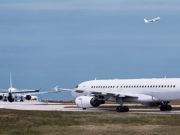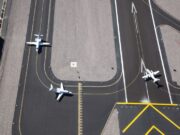
Commercial air transport (CAT) airlines1 registered in European Aviation Safety Agency (EASA) member states were involved in 15 accidents — none of them fatal — in 2017, according to EASA data.
In its Annual Safety Review 2018, EASA noted that the CAT airline accidents recorded in 2017 matched the number recorded in 2016; one of the 2016 crashes was a fatal accident (Figure 1).2
Figure 1 — Fatal Accidents, Nonfatal Accidents and Serious Incidents for CAT Airlines, 2007–2017
CAT = commercial air transport
Source: European Aviation Safety Agency
The number of serious incidents — which EASA defines as incidents involving circumstances that indicate an accident nearly occurred — for CAT airlines recorded in 2017 — 99 — declined from the 10-year high of 109 recorded in 2016; the relatively higher numbers of incidents in these two years resulted from a “more stringent classification of separation minima infringements,” the report said. In the two previous years, serious incidents numbered in the 60s.
Data showed the rate of accidents, including fatal accidents, and serious incidents in 2017 was 13 per 1 million flights (Figure 2). That figure represented a decline from 15 occurrences per million flights in 2016 — the highest annual rate in the five years from 2013 through 2017. The lowest rate was recorded in 2015 — 11 accidents and serious incidents per million flights.
Figure 2 — Fatal Accidents, Nonfatal Accidents and Serious Incidents for CAT Airlines, 2013–2017
CAT = commercial air transport
Source: European Aviation Safety Agency
Although no fatalities resulted from CAT airline accidents in 2017, 12 serious injuries were reported (Figure 3). In comparison, two fatalities and nine serious injuries were reported in 2016.
Figure 3 — Fatalities and Serious Injuries Involving CAT Airlines, 2007–2017
CAT = commercial air transport
Source: European Aviation Safety Agency
The report also said that, as in previous years, more CAT airline accidents and serious incidents occurred en route than in any other phase of flight. The document did not elaborate on what types of occurrences were included in this en route category. Data showed 42 en route accidents and serious incidents in 2017, compared with an annual average of 32.8.
Takeoff and landing accidents and serious incidents were second most frequent in 2017, with 19 accidents and serious incidents recorded in each category; in comparison, the annual averages from 2007 through 2016 were 18.8 takeoff accidents and serious incidents and 15.6 landing accidents and serious incidents.
Looking at all sectors of the industry, the report said the highest number of fatal accidents involved noncommercial operations, with 34 fatal accidents in 2017 (Table 1).
| Aircraft Domain | Fatal Accidents 2017 | Fatal Accidents 2007–2016 Mean | Fatalities 2017 | Fatalities Annual 2007–2016 Mean | Fatalities Annual 2007–2016 Median |
|---|---|---|---|---|---|
|
CAT = commercial air transport; NCC = noncommercial complex Source: European Aviation Safety Agency |
|||||
| Airplanes | |||||
| CAT — Airlines | 0 | 0.9 | 0 | 66.4 | 4.0 |
| NCC — Business | 0 | 0.4 | 0 | 0.6 | 0.0 |
| Specialized operations | 3 | 7.3 | 4 | 18.1 | 16.5 |
| Noncommercial operations | 34 | 50.1 | 62 | 92.2 | 91.0 |
| Rotorcraft | |||||
| Offshore CAT | 0 | 4.0 | 0 | 3.6 | 0.0 |
| Onshore CAT | 1 | 1.7 | 6 | 5.4 | 6.0 |
| Specialized operations | 3 | 4.0 | 4 | 7.5 | 6.0 |
| Noncommercial operations | 3 | 10.2 | 7 | 18.7 | 19.0 |
| Balloons | 3 | 5.6 | 7 | 13.2 | 12.5 |
| Sailplanes | 25 | 25.4 | 27 | 29.5 | 29.5 |
“This domain also has the highest mean number of fatal accidents and the highest mean and median number of fatalities over the preceding 10 years,” the report said. “By contrast, there were no fatal accidents in CAT airlines, NCC [noncommercial complex] business and offshore CAT rotorcraft in 2017.”
In that 10-year period from 2007 through 2016, the lowest mean number of fatal accidents a year was recorded in commercial air transport, the report said. The lowest number of fatalities was recorded in NCC-business operations, followed by offshore CAT helicopters.
Despite the absence in 2017 of fatal CAT airline accidents, the fatal accidents in EASA member states involving other sectors of the industry, as well as fatal accidents worldwide in the earliest weeks of 2018, “demonstrate the need to continuously drive safety improvements across the board, to share lessons learned,” said EASA Executive Director Patrick Ky.
“This is achieved through the safety actions that are identified in the European Plan for Aviation Safety (EPAS). In partnership with our member states, we are developing a better view of safety and defining a collective response. Additionally, EASA coordinates beyond Europe at a global level in order to help protect our citizens when they travel beyond our borders” (see “A New Way to Measure”).
Data showed that 2017 was the fourth consecutive year without a fatal accident involving an NCC business flight3 from any EASA member state. NCC business flights were involved in no nonfatal accidents in 2017, the report said, adding that five serious incidents were reported (Figure 4). In the 10 years from 2007 through 2016, the annual number of nonfatal accidents ranged from one to three, and the annual number of serious incidents, from two to eight.
Figure 4 — Fatal Accidents, Nonfatal Accidents and Serious Incidents for NCC Business Operations, 2007–2017
NCC = noncommercial complex
Source: European Aviation Safety Agency
Notes
- CAT airline operations are those involving airline passenger and/or cargo airplanes with a maximum takeoff weight of more than 5,700 kg (12,566 lb) that are registered in EASA member states.
- EASA. Annual Safety Review 2018.
- NCC business operations are those involving complex airplanes with a maximum takeoff weight of more than 5,700 kg that are registered in EASA member states and are not being flown for purposes classified as special operations.


